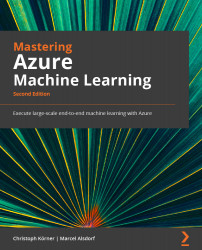Summary
In this chapter, we introduced hyperparameter optimization through HyperDrive and model optimization through Automated Machine Learning Both techniques can help you efficiently retrieve the best model for your ML task.
Grid sampling works great with classical ML models, and also when the number of tunable parameters is fixed. All the values on a discrete parameter grid are evaluated. In random sampling, we can apply a continuous distribution for the parameter space and select as many parameter choices as we can fit into the configured training duration. Random sampling performs better on a large number of parameters. Both sampling techniques can/should be tuned using an early stopping criterion.
Unlike random and grid sampling, Bayesian optimization probes the model performance to optimize the following parameter choices. This means that each set of parameter choices and the resulting model performance are used to compute the next best parameter choices. Therefore, Bayesian...



